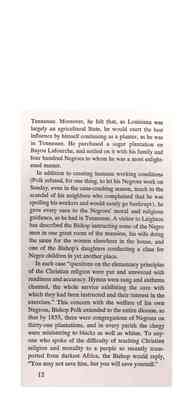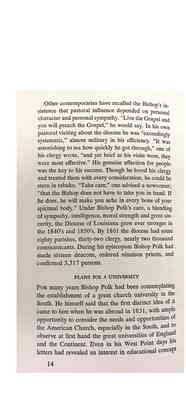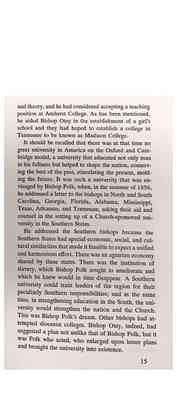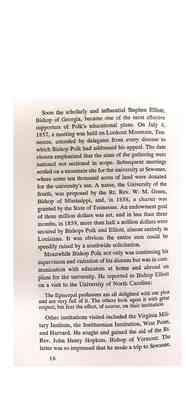Pages
16
Tennessee. Moreover, he felt that, as Louisiana was largely an agricultural State, he would exert the best influence by himself continuing as a planter, as he was in Tennessee. He purchased a sugar plantation on Bayou Lafourche, and settled on it with his family and four hundred Negroes to whom he was a most elightened master.
In addition to creating humane working conditions (Polk refused, for one thing, to let his Negroes work on Sunday, even in the cane-crushing season, much to the scandal of his nceighbors who complained that he was spoiling his workers and would surely go bankrupt), he gave every care to the Negroes' moral and religious guidance, as he had in Tennessee. A visitor to Leighton has described the Bishop instructing some of the Negro men in one great room of the mansion, his wife doing the same for the women elsewhere in the house, and one of the Bishop's daughters conducing a class for Negro children in yet another place.
In each case "questions on the elementary principles of the Christian religion were put and answered with readiness and accuracy. Hymns were sung and anthems chanted, the whole service exhibiting the care with which they had been instructed and their interest in the exercises." This concern with the wellness of his own Negroes, bishop Polk extended to the entire diocese, so that by 1855, there were congregations of Negroes on thirty-one plantations, and in every parish the clergy were ministering to blacks as well as whites. To anyone who spoke of the difficulty of teaching Christian religion and morality to a people so recently transported from darkest Africa, the Bishop would reply, "You may not save him, but you will save yourself."
12
17
The Bishop found, however, that the details of plantation management conflicted with the manifold task of diocesan visiting and supervision. In 1854, after an unusually vexing period of difficulties on the plantation --several years of bad crops, cholera and yellow fever (the Bishop was himself a victim), he decided to remove to New Orleans. Up to this time he had served the diocese virtually without compensation, supporting himself and family by his planting operations and contributing of his own income to church causes. He was now to receive a salary of $4,000 a year. The diocese, which had possessed but two church buildings and five clergymen when he became bishop, by 1854 contained fifty-five congregations, twenty church buildings, and twenty-five clergymen. Communicants had increased from 238 to 1,421. In 1855 the Bishop took an active part in the organization of a congregation of Free Negroes in New Orleans.
LIVE THE GOSPEL
ALL accounts agree that Bishop Polk was respected and revered by his clergy and people. One of the priests of the diocese thus describes his first interview with the Bishop:
One glance revealed the man; his first address the gemtleman; his penetrating. sympathetic look, the friend and father. He was then over fifty years of age, but his clear complexion, his keen, bright eye, and his elastic step made him appear not more than 46 or 48. Standing over six feet in height, his form was cast in the ideal mold of the soldier. ...I was in some way conscious that an eye accustomed to observe, and gifted with the insight of sympathy, had taken a quick and comprehensive observation of me. I did not at all feel that I had been scrutinized; I did feel that I was understood.
13
18
Other contemporaries have recalled the Bishop's insistence that pastoral influence depended on personal character and personal sympathy. "Live the Gospel and you will preach the Gospel," he would say. In his own pastoral visiting about the diocese he was "exceedingly systematic," almost military in his efficiency. "It was astonishing to see how quickly he got through," one of his clergy wrote, " and yet brief as his visits were, they were most effective." His genuine affection for people was the key to his success. Though he loved his clergy and treated them with every consideration, he could be stern in rebuke. "Take care," one advised a newcomer, "that the Bishop does not have to take you in hand. If he does, he will make you ache in every bone of your spiritual body." Under Bishop Polk's care, a blending of sympathy, intelligence, moral strength and great sincerity, the Diocese of Louisiana grew ever stronger in the 1840's and 1850's. By 1861 the diocese had some eighty parishes, thirty-two clergy, nearly two thousand communicants. During his episcopate Bishop Polk had made sixteen deacons, ordered nineteen priests, and confirmed 3,317 persons.
PLANS FOR A UNIVERSITY
For many years Bishop Polk had been contemplating the establishment of a great church university in the South. He himself had said that the first distinct idea of it came to him when he was abroad in 1831, with ample opportunity to consider the needs and opportunities of the American Church, especially in the South, and to observe at first hand the great universities of England and the Continent. Even in his West Point days his letters had revealed an interest in educational concept
14
19
and theory, and he had considered accepting a teaching position at Amherst College. As has been mentioned, he aided Bishop Otey in the establishment of a girl's school and they had hoped to establish a college in Tennessee to be known as Madison College.
It should be recalled that there was at that time no great university in America on the Oxford and Cambridge model, a university that educated not only man in his fullness but helped to shape the nation, conserving the best of the past, stimulating the present, molding the future. It was such a university that was envisaged by Bishop Polk, when, in the summer of 1856, he addressed a letter to the bishops in North and South Carolina, Georgia, Florida, Alabama, Mississippi, Texas, Arkansas, and Tennessee, asking their aid and counsel in the setting up of a Church-sponsored university in the Southern States.
He addressed the Southern bishops because the Southern States had special economic, social and cultural similarities that made it feasible to expect a unified and harmonious effort. There was an agrarian economy shared by these states. There was the institution of slavery, which Bishop Polk sought to ameliorate and which he knew in time would disappear. A Southern university could train leaders of the region for their peculiarly Southern responsibilities; and at the same time, in strengthening education in the South, the university would strengthen the nation and the Church. This was Bishop Polk's dream. Other bishops had attempted diocesan colleges. Bishop Otey, indeed, had suggested a plan not unlike that of Bishop Polk, but it was Polk who acted, who enlarged upon lesser plans and brought the university into existence.
15
20
Soon the scholarly and influential Stephen Elliott, Bishop of Georgia, became one of the most effective supporters of Polk's educational plans. On July 4, 1857, a meeting was held on Lookout Mountain, Tennessee, attended by delegates from every diocese to which Bishop Polk had addressed his appeal. The date chosen emphasized that the aims of the gathering were national not sectional in scope. Subsequent meetings settled on a mountain site for the university at Sewanee, where some ten thousand acres of land were donated for the university's use. A name, the University of the South, was proposed by the Rt. Rev. W. M. Green, Bishop of Mississippi, and in 1858, a charter was granted by the State of Tennessee. An endowment goal of three million dollars was set, and in less than three months, in 1859, more than half a million dollars were secured by Bishops Polk and Elliott, almost entirely in Louisiana. It was obvious the entire sum could be speedily raised by a southwide solicitation.
Meanwhile Bishop Polk not only was continuing his supervision and visitation of his diocese but was in communication with educators at home and abroad on plans for the university. He reported to Bishop Elliott on a visit to the University of North Carolina:
The Episcopal professors are all delighted with our plan and are very full of it. The others look upon it with great respect, but fear the effect, of course, on their institution.
Other institutions visited included the Virginia Military Institute, the Smithsonian Institution, West Point, and Harvard. He sought and gained the aid of the Rt. Rev. John Henry Hopkins, Bishop of Vermont. The latter was so impressed that he made a trip to Sewanee,
16




